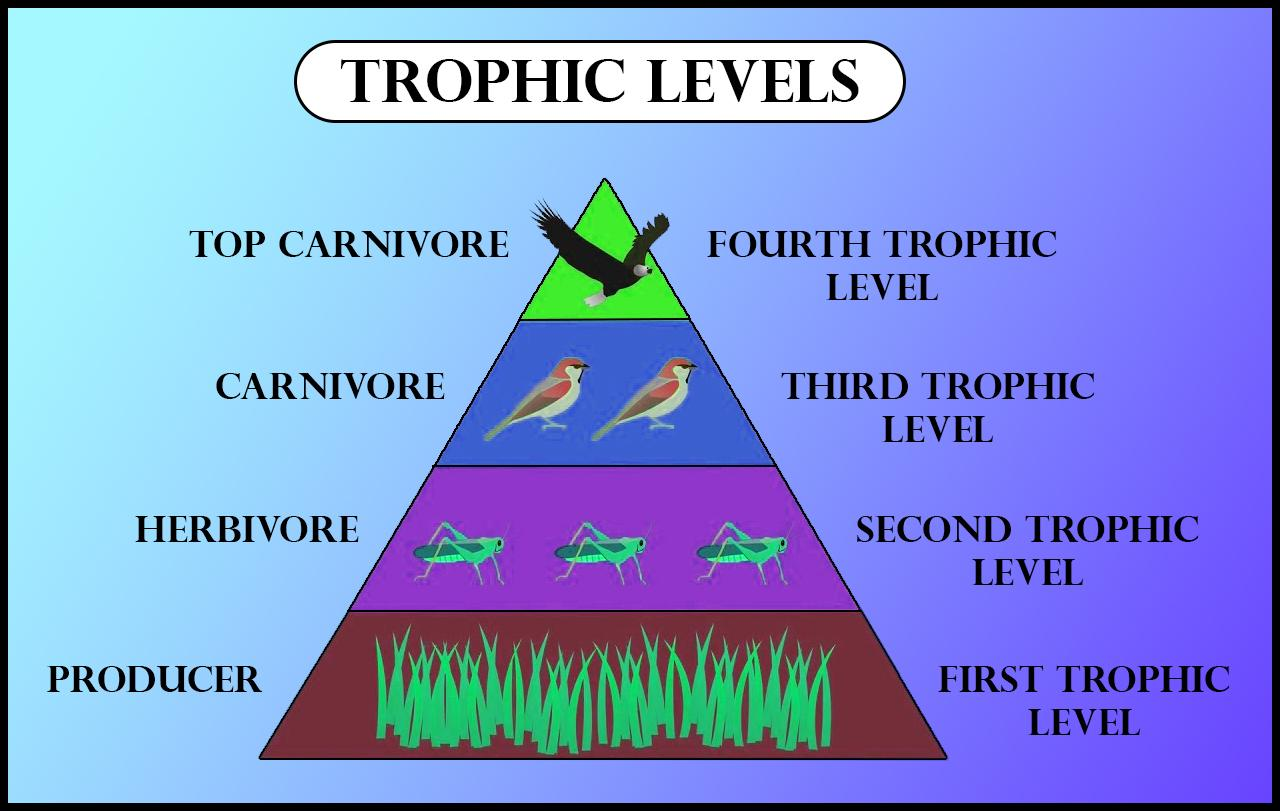
In an ecosystem second trophic level occupied by _______.
Answer
555.9k+ views
Hint Ecosystem consists of a wide variety of flora and fauna which interact and exchange materials among themselves and others. Trophic levels are the levels at which organisms obtain their food, every level of organisms feed on the lower level of organisms.
Complete Answer:
In an ecosystem second trophic level occupied by herbivores which feed on plants. These herbivores may zooplankton, grasshopper, seed-eating birds, grazing animals, and leaves eating caterpillars.
In the case of trophic levels, the first trophic level is occupied by producers which form food by an external source of energy. Third trophic level occupied by primary carnivores which prey upon herbivores like an insect-eating bird, fishes, wolf, and lion. The fourth trophic level consists of secondary carnivores that eat primary carnivores like man, lion, and snake eating hawks.
Additional information:
An ecosystem consists of two types of components biotic and abiotic. The biotic component includes producers, consumers, and decomposers. Producers include those organisms which manufacture organic food from inorganic raw materials. These include green plants, yellow-green algae, brown-red algae, cyanobacteria, green and purple bacteria, etc. Producers maintain oxygen-carbon dioxide balance by photosynthesis and chemical breakdown. Consumers are heterotrophs including both herbivores and carnivores. It includes aerobic organisms that consume mainly organic nutrients. All animals are consumers. Decomposers are saprotrophic organisms included under heterotrophs that do not ingest organic matter but consume their digestive enzyme in fluid form. It liberates inorganic nutrients therefore also known as mineralizers.

Note: Decomposers are the main component of an ecosystem that is placed at the sixth trophic level in the terrestrial ecosystem but in the case of the aquatic ecosystem, it is placed at the seventh trophic level. More than one trophic level occupied by the same organisms but considered at the same level.
Complete Answer:
In an ecosystem second trophic level occupied by herbivores which feed on plants. These herbivores may zooplankton, grasshopper, seed-eating birds, grazing animals, and leaves eating caterpillars.
In the case of trophic levels, the first trophic level is occupied by producers which form food by an external source of energy. Third trophic level occupied by primary carnivores which prey upon herbivores like an insect-eating bird, fishes, wolf, and lion. The fourth trophic level consists of secondary carnivores that eat primary carnivores like man, lion, and snake eating hawks.
Additional information:
An ecosystem consists of two types of components biotic and abiotic. The biotic component includes producers, consumers, and decomposers. Producers include those organisms which manufacture organic food from inorganic raw materials. These include green plants, yellow-green algae, brown-red algae, cyanobacteria, green and purple bacteria, etc. Producers maintain oxygen-carbon dioxide balance by photosynthesis and chemical breakdown. Consumers are heterotrophs including both herbivores and carnivores. It includes aerobic organisms that consume mainly organic nutrients. All animals are consumers. Decomposers are saprotrophic organisms included under heterotrophs that do not ingest organic matter but consume their digestive enzyme in fluid form. It liberates inorganic nutrients therefore also known as mineralizers.

Note: Decomposers are the main component of an ecosystem that is placed at the sixth trophic level in the terrestrial ecosystem but in the case of the aquatic ecosystem, it is placed at the seventh trophic level. More than one trophic level occupied by the same organisms but considered at the same level.
Recently Updated Pages
Master Class 12 Business Studies: Engaging Questions & Answers for Success

Master Class 12 Economics: Engaging Questions & Answers for Success

Master Class 12 English: Engaging Questions & Answers for Success

Master Class 12 Maths: Engaging Questions & Answers for Success

Master Class 12 Social Science: Engaging Questions & Answers for Success

Master Class 12 Chemistry: Engaging Questions & Answers for Success

Trending doubts
What are the major means of transport Explain each class 12 social science CBSE

Which are the Top 10 Largest Countries of the World?

Draw a labelled sketch of the human eye class 12 physics CBSE

Explain sex determination in humans with line diag class 12 biology CBSE

The pH of the pancreatic juice is A 64 B 86 C 120 D class 12 biology CBSE

Explain sex determination in humans with the help of class 12 biology CBSE




